Setting up the Chatbot Server
Set up the Chatbot Server for the Reference Chatbot (Facebook Messenger).
Environment File
The application requires some information that can be stored either in a environment file (.env) or as constants directly in the code.
Example of .env file:
VERIFY_TOKEN='<Randomly_Generated_Token_To_Provide_To_Facebook>'
PAGE_ACCESS_TOKEN='<Token_Provided_By_Facebook>'
EP_SERVER='http://<Customer_demo_url>/cortex'
EP_SCOPE='<Customer_Store>'
EP_IMAGES='https://s3-us-west-2.amazonaws.com/<link_to_images>/'
Example of constants:
const VERIFY_TOKEN = '<Randomly_Generated_Token_To_Provide_To_Facebook>';
const PAGE_ACCESS_TOKEN='<Token_Provided_By_Facebook>';
const EP_SERVER='http://<Customer_demo_url>/cortex';
const EP_SCOPE='<Customer_Store>';
const EP_IMAGES='https://s3-us-west-2.amazonaws.com/<link_to_images>/';
Run the application
- Run the
cd chatbotcommand. - To install dependencies, run the
npm installcommand. - To run the application, run the
node app.jscommand. - Configure the
./src/ep.config.jsonfile as required for the environment. For more information, see the Configuration Parameter Descriptions section. - Run
npm startto start the server in development mode. The following message is displayed:
Tip: To stop the application, press <Ctrl>-C.
Configure the Facebook API
In this part, we are going to assume that you already created a Facebook business page. If you did not, please review the appendices first.
- Go to Facebook for developer and log in with the page admin credentials. If you have multiple pages on this account, select the account where you want to create the chatbot.
- On the sidebar, click the (+) button next to Products, and search for
Messenger. It should be one of the first three products. - Click Set Up to configure Messenger.
Messengerappears in the sidebar. - In the Set Up page, you should see a block called
Token Generation. Select your Facebook page in this block. Facebook creates a random token. Copy the token, go to your environment file or constant, and populate the fieldPAGE_ACCESS_TOKEN. - At the top of the page, you should see
APP ID: <TOKEN>. Copy<TOKEN>and go to your Facebook page. - Click
Settingson the top-right corner of the page. - On the sidebar, click Messenger Platform and scroll down to
Subscribed Apps, which should be empty for now. - Just below this block, you can see
Link your App to Your Pagein the field. Paste the<TOKEN>you previously copied and clickLink. This populates the blockSubscribed Apps. - Go to Facebook for developer.
- On the sidebar, click Roles. From the menu that opens, click Roles.
- You can see
Administratorswith your Facebook account andTesterswith none in this block. - Click
Add Testers. In the dialog box, search for your tester account and click submit. - Open a new incognito page and head to Facebook. Log in as the tester.
- You should get a notification from your business page. Click accept to become a tester.
The Facebook API is now configured and the tester is able to test the chatbot.
Deploy the application
For the final configuration step, it is required first to deploy the application.
Go to /etc/apache2/sites-available and update 000-default.conf to add this:
ProxyPass /chatbot http://127.0.0.1:<PORT>
ProxyPassReverse /chatbot http://127.0.0.1:<PORT>
<PORT>is the port used by the node application.
Facebook will not accept not secure communication, so you need to install an SSL certificate from a valid CA. We are going to use Let’s Encrypt for this part.
Run the command
sudo add-apt-repository ppa:certbot/certbot.Run
sudo apt-get update.Run
sudo apt-get install python-certbot-apache.Run
sudo certbot --apache -d <Customer>.epdemos.com, where<Customer>is the subdomain that you are using.Complete the form from certbot. Ensure that
httpdoes not redirect tohttpsby default. If it redirects, applications such as, Cortex, Commerce Manager, and Studio from port80to port443will cause issues making requests. For example, requests are redirected, causing theHTTPcode to be30Xinstead of20X.You should have a new file:
/etc/apache2/sites-available/000-default-le-ssl.conf. This file contains the exact same thing as000-default.confbut for port443.Run
npm install -g forever.Go to the Github repository of the chatbot and run
forever start app.js. This runs the Node application as a background task and you can get control and leave the Virtual Machine (VM) without stopping the application.Copy the content of the
VERIFY_TOKENconstant or property. If you did not create a token, generate one first. Use a 40 to 50 character long token containing digits and capitalized letters.Go to Facebook for developer.
Click
Add subscriptionorEdit subscriptionand paste the token in theVerify TokenfieldIn the callback URL field add
https://<Customer>.epdemos.com/chatbot/webhook, where<Customer>is the subdomain of your application.Click
Verify and Save. If this doesn’t work, in theCallback URLfield, there should be a red cross on the right. Hover over the red cross to see the cause of the error.- If you get a 404 error, it is likely that the deployment went wrong or that the application crashed.
- If you get a 403 error,you have a configuration issue in your
.envfile or in your constants.
To debug these issues:
- Run
forever stop app.js. - In the first method
app.get('/webhook', (req, res) => {..., add logs to check the values oftoken(which should be yourVERIFY_TOKEN) andmode(which should besubscribe).
Build a docker image
The application contains a Docker folder that contains a Dockerfile and a Shell script. The Dockerfile uses a NodeJS image and contains multiple arguments that you can populate by using the --build-args argument when building the image. These Docker arguments are used in the Shell script to replace the constants in the code, which makes the chatbot easier to deploy and maintain.
| Parameter | Importance | Type | Description |
|---|---|---|---|
PAGE_ACCESS_TOKEN | Required | String | The token that is provided by Facebook on (developers.facebook.com) for each application. |
VERIFY_TOKEN | Required | String | The token that you have to generate and pass to Facebook when configuring the webhooks. |
SCOPE | Required | String | Name of the store from which Cortex retrieves data. |
S3_URL | Required | String | URL that consists of the path to images hosted on an external CMS (Content Management System). Set this parameter to the complete URL of the images by replacing the <link_to_images> with the path of your images. |
FIREBASE_API_KEY | Required | String | Your Firebase API key. |
FIREBASE_AUTH_DOMAIN | Required | String | This is the unique domain provided by Firebase for your application. |
FIREBASE_APP_NAME | Required | String | This is the name you use to register your application on Firebase. |
FIREBASE_DB_URL | Required | String | This is the database URL that Firebase provides. |
Features
In its current state, the chatbot is able to perform the following actions:
- It contains regular actions that are triggered by clicking on buttons in the Messenger application:
- Login to Cortex
- Add an item to the cart
- Add an item to the wishlist
- Checkout
- Move an item from the cart to the wishlist and vice-versa
- Contains 3 nlp features that use a limited vocabulary.
- You can search items based on keywords. For example,
search for golf bagtriggers a search request with keywordsgolfandbag.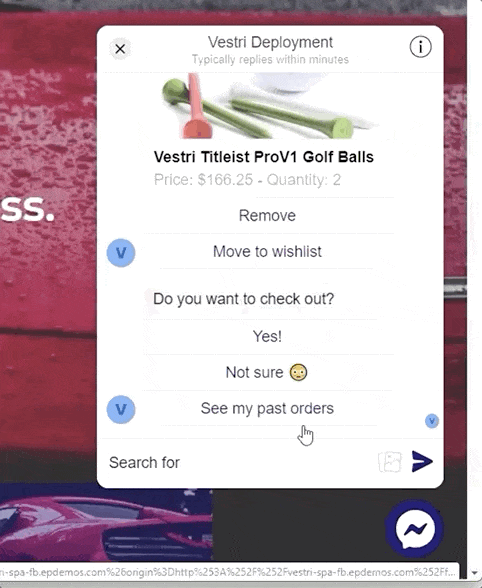
- You can add items in your cart based on keywords and on quantity. For example,
add 3x golf bagtriggers a search based ongolfandbagand sends a response that enables the user to add 3 of the found items in their cart.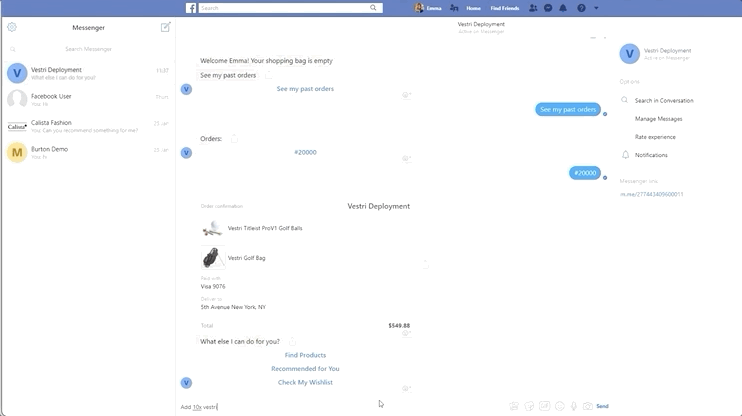
- You can apply a promotion coupon. For example,
apply REDUCTION10will apply theREDUCTION10coupon if it exists.
- You can search items based on keywords. For example,
- Ability to link a Facebook account to a Cortex account.
- This is done by authenticating on the login application that is included in the chatbot, this application exposes a form that that performs authentication requests to a Cortex server.
Create tests
Go to Facebook and log in as the tester.
Go to the page to test and click
Send Message.Write anything in the chat box, and the chatbot should reply with:
Welcome back, Emma. You don’t have items in your shopping bag. How can I help you today?Go to Studio and log in as the tester. Ensure that you have all the required information set up.
Add items to your cart and go back to Facebook.
Write anything in the chat box and you should see something similar to the following image:
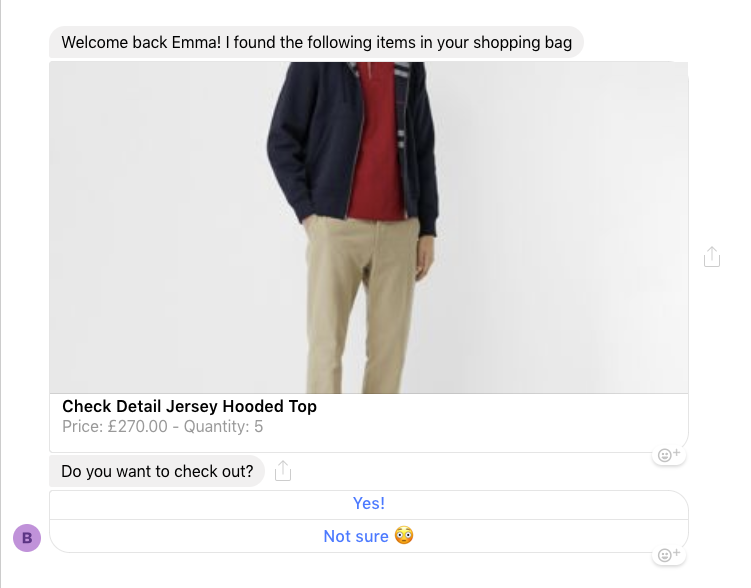
Select a response.
- If you click Not Sure, the bot puts the items in your wishlist.
- If you click Yes, the bot passes the order:

Click on the order to have a new component pop up:
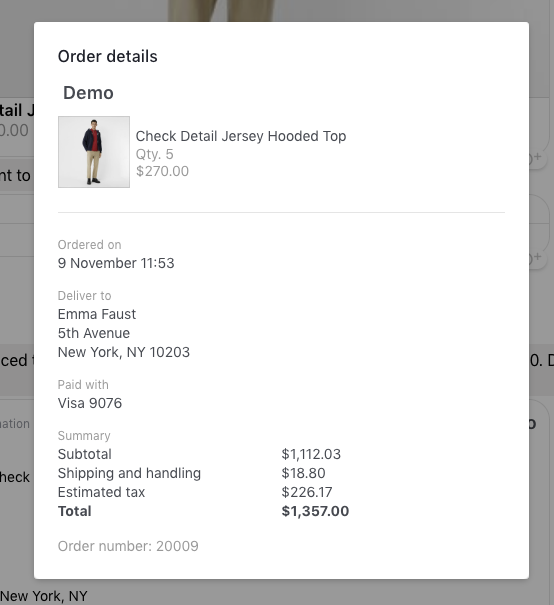
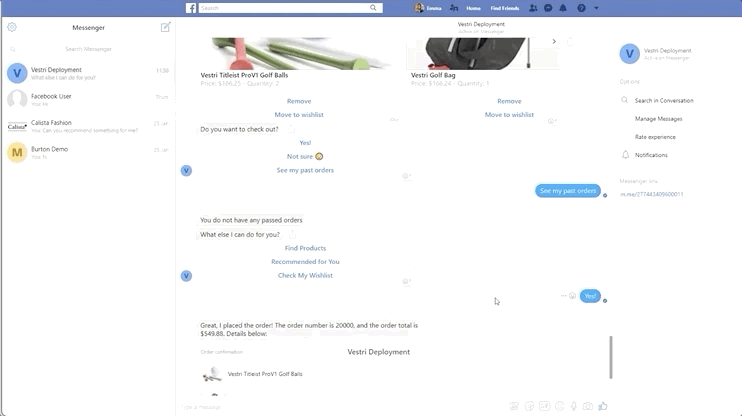
At this point, the chatbot is up and running.
Appendices
For quick reference, here are the steps to create a Facebook business page. For current instructions, see the Facebook documentation.
- Log in as your page admin account.
- In the sidebar, click Pages, just in the
Exploreblock. - Click
Create Pageon the top right corner and clickBusiness or Brand, add a page name and a category (Clothing, Brand, Computers...). - Click continue. If this is your first page, you will be asked to add a cover photo and a profile picture. You can skip this step if you want.